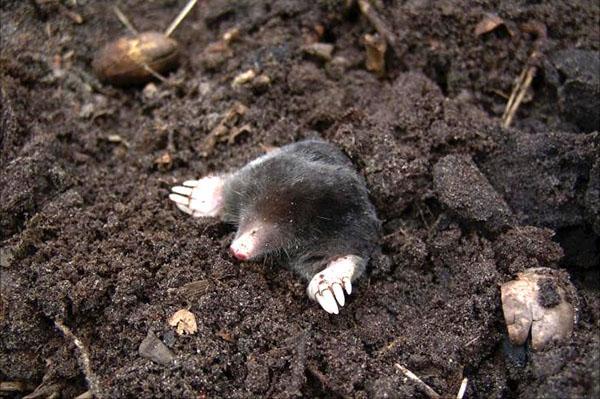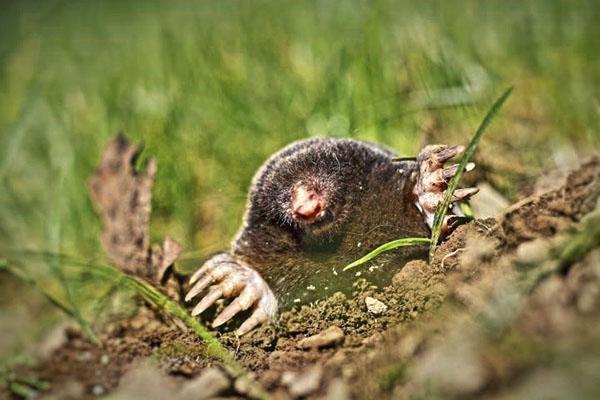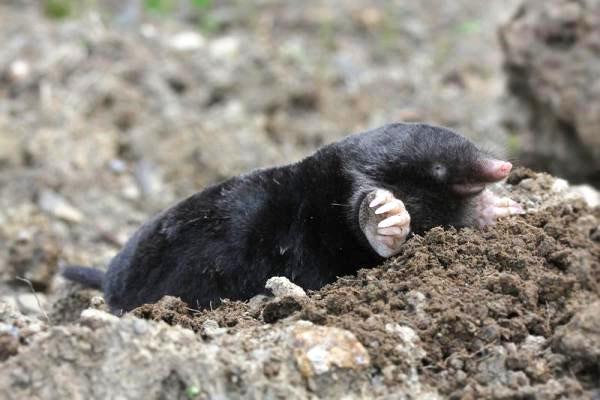Moles: how to identify and get rid of pests
 Moles can do a lot of harm. In this article, we will share our experience and talk about how to detect the presence of these animals on your site and what measures to take to say goodbye to them forever.
Moles can do a lot of harm. In this article, we will share our experience and talk about how to detect the presence of these animals on your site and what measures to take to say goodbye to them forever.
Who are moles

If there is a significant increase in the population of moles or other similar pests in your area, this suggests trouble ahead. Moles are usually found in areas where the soil is rich in organic matter. Their presence in excessively large numbers may be associated with a high number of soil pests. Thus, moles are a signal that not all is well with the soil.
 Outwardly, these amazing little mammals are similar to the Idaho potatoes. They have a pointed muzzle, tiny eyes, and a small body. Moving underground, they actually swim in the soil, using their wide front flippers to make their way. The animals prefer moist loamy soil and are especially active in the early morning or evening in spring and autumn. After a warm rain, their little faces can be seen on the surface.
Outwardly, these amazing little mammals are similar to the Idaho potatoes. They have a pointed muzzle, tiny eyes, and a small body. Moving underground, they actually swim in the soil, using their wide front flippers to make their way. The animals prefer moist loamy soil and are especially active in the early morning or evening in spring and autumn. After a warm rain, their little faces can be seen on the surface.
A distinctive feature of moles is a pointed muzzle with no hair. The eyes and ear canals are hidden under the fur, and the outer ears are missing. Wide forelegs with webbed toes and narrow hind legs with thin claws help to move easily underground. Typically, adults reach 17 cm in length and weigh about 1.5 kg.
What harm do moles do
 Seemingly cute and innocent creatures can bring a lot of problems:
Seemingly cute and innocent creatures can bring a lot of problems:
- In addition to insect pests and larvae, the diet of moles includes beneficial soil organisms such as earthworms.
- Unlike voles, moles dig deep holes. Usually their tunnels run at least 25 cm below the surface, unless they are looking for a mate. Check your lawn for these burrows (they look like raised, volcano-like heaps).
- Along the paved passages, various pests gain unhindered access to plants, and it becomes more difficult to detect them.
Surface tunnels and long embankments also indicate mole activity.
How to get rid of moles
Several of the following methods will help you drive earthy guests from the site.
The first effective step is to treat the soil with dried blood, tobacco, or a similar repellent. Remember to repeat the procedure after every rain.
 A cat that loves to walk in the garden is a great deterrent for many rodents.
A cat that loves to walk in the garden is a great deterrent for many rodents.
 Moles are carnivores that make themselves at home on lawns rich in maggots and insects. If their food tastes like castor oil, they will leave to feed elsewhere. Mix 3 parts castor oil to 1 part dish soap. Stir with 4.5 L of water and pour over tunnels and entrances.
Moles are carnivores that make themselves at home on lawns rich in maggots and insects. If their food tastes like castor oil, they will leave to feed elsewhere. Mix 3 parts castor oil to 1 part dish soap. Stir with 4.5 L of water and pour over tunnels and entrances.
Dip an ear of corn into the roofing resin and place it in one of the tunnels. Moles hate the smell of tar, and their path will be blocked.
Powdered red pepper scattered at burrow entrances also scares animals away, and coffee beans scattered on the ground discourage moles from digging tunnels.
 Perhaps you are lucky and by using wind energy and creating vibration in the ground, you can bring discomfort to underground inhabitants, thereby driving them away. Simple scarers can be made from plastic bottles with slots on sticks. The stick is driven into the ground near the entrance to the hole, and the vibration and noise generated by the wind irritate the moles.
Perhaps you are lucky and by using wind energy and creating vibration in the ground, you can bring discomfort to underground inhabitants, thereby driving them away. Simple scarers can be made from plastic bottles with slots on sticks. The stick is driven into the ground near the entrance to the hole, and the vibration and noise generated by the wind irritate the moles.
 If the problem with moles is not resolved, then capture is the best solution. This is often the only way to get rid of them. Use a humane trap and release the animal at least 8 km from your home and far from someone else's garden.
If the problem with moles is not resolved, then capture is the best solution. This is often the only way to get rid of them. Use a humane trap and release the animal at least 8 km from your home and far from someone else's garden.
Preventive measures
A few steps to prevent the invasion of moles in your garden will help solve an impending problem before it arises:
- Check the soil for the presence of pests: if there are many moles, then there is an excess of larvae and beetles in the ground. Try spraying the area with milky spores or beneficial nematodes to get rid of the larvae. The same remedy works for the Japanese beetle.
- If you want to protect a particular plant, dig a hole about a meter deep and line the walls with wire mesh. Then fill the hole with soil with the seedling.
- Plant plants that moles don't like. These include marigold, marigolds, castor plants, garlic and onions.

Moles are often blamed for damage caused by field mice because of their similarity.
Starting the fight against moles in the garden, remember that these animals also have a useful function, destroying harmful insects and slugs. If underground animals began to seriously spoil your site, try not to harm them, but to catch them with humane means and release them in rural areas a few kilometers from home.